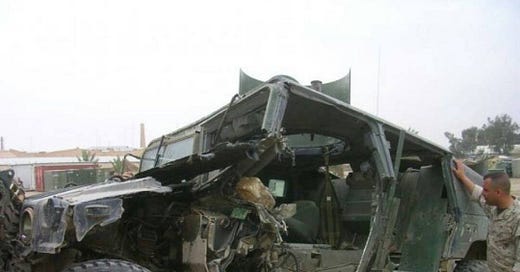Eighteen Years After My Husband was Wounded in Iraq, the Military Continues Failing Servicemembers
Somehow, it has been eighteen years since my husband survived an IED blast in Iraq. That’s his unarmored humvee up there. He told me while he was in the hospital that the bomb had been double-stacked, that he heard someone warning him over the radio just before the blast went off. He was the driver and didn’t have enough time to respond. Other Marines pulled him from his Humvee, but he didn’t remember that part. By the time he regained consciousness, he was lying on the hot ground, his leg draped over his chest “like a noodle.” He was the only one with a wound severe enough to be flown back to The States.
Over a year later, Cleve and I were driving down Lejuene Blvd as up-armored humvees coasted past us on the back of 18-wheelers toward Camp Lejeune—a parade of them, easily recognizable for their bulkier frames and sand-colored exteriors.
We were expecting them to arrive. The previous year, while in Bethesda—where Cleve had been receiving treatment at what is now called Walter Reed National Military Medical Center—the Commandant of the Marine Corps, General Conway, treated a bunch of wounded guys and their families to dinner at Dave & Busters. There, as we gnawed on chicken wings and chugged cheap beer to the dings, bleeps, and bloops of video games, he told us—proudly—that the Marine Corps had ordered some ridiculously large number of up-armored humvees to send to Iraq and Afghanistan. Marines would be safer now, he said. He smiled. I looked at Cleve and took a sip of my beer.
Any time the commandant was around—which was pretty regularly—Cleve sat a little straighter. I looked down at Cleve’s gnarled leg—at the dark circles under his eyes. I looked around the room at the men in wheelchairs, men with prosthetics, men wearing helmets, missing eyes, covered in scars, and their families sitting next to them, haggard. I wondered, with all the funding the military gets, what had taken the Marine Corps so damn long to get armored vehicles.
During the four years I was married into the military, I noticed a tendency toward being reactive over proactive. It was demoralizing. How many life-altering wounds—how many deaths—does it take to convince the military to spend money on life-saving equipment? I dunno. A lot?
I saw it again as Cleve became addicted to his prescribed pain medications. He’d been showing signs of addiction for nearly two years, but doctors didn’t seem concerned. When he overdosed on his Oxycontin in the Fall of 2008, the country was at the first peak of an opioid crisis. I was 22 and had no idea. His friend overdosed and died in the barracks on base, just across from the hospital. If you listened closely enough, you’d the guys whispering about swapping their pills, taking them recreationally to self-treat PTSD and TBI. It was a problem. There was no way the military didn’t notice.
Cleve died in 2010 from an overdose of Fentanyl, the drug he was prescribed by the military and then by the VA for pain associated with his amputation. Fourteen years later, last January, The Washington Post published this piece about the Fentanyl problem in the Army. According to this, more soldiers are dying from overdoses than they are in combat. In the last five years, 332 soldiers have died from overdose, and over 15,000 overdosed but survived. What the actual fuck? Cleve’s first overdose was 16 years ago. This has been going on for at least that long. Why isn’t more being done?
An Alive Day in the military is often a day of celebration. It’s the day you came close to death but survived; the day you were given a second chance at life. Cleve and I used to celebrate his. On April 1st each year, we’d go to a nice restaurant. Maybe we’d get a little cake or invite some friends over for a small party. He celebrated four of them before the Fentanyl took his life. Now, on his Alive Day, I can only think of the date that comes next: April 20th. The day the military failed him one last time. The day he died.
My husband’s death is one of countless, all adding up to whatever magic number the military has decided equals enough to try to fix this. Or maybe they don’t intend to fix it at all. Maybe they see servicemembers as expendable. Maybe it’s easier (cheaper) to let them die than to help them get better. I don’t fucking know anymore.






I had no idea. Thank you for highlighting this awful waste of life.
So much love to you, friend. I’m sorry.